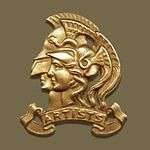Artists Rifles
| The Artists Rifles | |
|---|---|
|
Cap badge of The Artists Rifles | |
| Active |
1859–1945 1947–present |
| Country |
|
| Branch | The Army Reserve |
| Type |
Infantry Officer Training (prior to 1947) Long-range reconnaissance patrol |
| Role | Reconnaissance and long range patrols (current) |
| Part of | 1st Intelligence, Surveillance and Reconnaissance Brigade |
| Engagements | Boer War, World War I |
| Decorations | 8 VCs, 56 DSOs, 893 MCs, 26 DFCs, 15 AFCs, 6 DCMs, 15 MMs, 14 MSMs, 564 MIDs (World War I) |
| Battle honours |
Boer War: South Africa 1900–01. |
| Commanders | |
| Notable commanders | Henry Wyndham Phillips and Frederic Leighton |
The Artists Rifles[nb 1] is a regiment of the British Army Reserve. Raised in London in 1859 as a volunteer light infantry unit, the regiment saw active service during the Second Boer War and World War I, earning a number of battle honours. It did not serve outside Britain during World War II, as it was used as an officer training unit at that time. The regiment was disbanded in 1945 but in 1947, it was re-established to resurrect the Special Air Service Regiment.[2] Today, the full title of the Regiment is 21 Special Air Service Regiment (Artists) (Reserve) (21 SAS(R)) and with 23 Special Air Service Regiment (Reserve) (23 SAS(R)), it forms the Special Air Service (Reserve) (SAS(R)).
History
Formation and 19th century
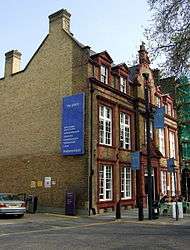
The regiment was formed in 1859, part of the widespread volunteer movement which developed in the face of potential French invasion after Felice Orsini's attack on Napoleon III was linked to Britain.[3] The group was organised in London by Edward Sterling, an art student, and comprised various professional painters, musicians, actors, architects and others involved in creative endeavours; a profile it strove to maintain for some years. It was established on 28 February 1860 as the 38th Middlesex (Artists') Rifle Volunteer Corps, with headquarters at Burlington House.[1] Its first commanders were the painters Henry Wyndham Phillips and Frederic Leighton. The unit's badge, designed by J. W. Wyon, shows the heads of the Roman gods Mars and Minerva in profile.[4] Until 1914 the regimental full dress uniform was light grey with white facings, silver buttons and braid. This distinctive uniform dated from the regiment's foundation as a volunteer unit. After World War I standard khaki was the normal dress.[5]
In September 1880, the corps became the 20th Middlesex (Artists') Rifle Volunteer Corps, with headquarters at Duke's Road, off Euston Road, London (now The Place, home of the Contemporary Dance Trust). It formed the 7th Volunteer Battalion of the Rifle Brigade from 1881 until 1891 and the 6th Volunteer Battalion from 1892 to 1908. During this period, The Artists Rifles fought in the Second Boer War as part of the City Imperial Volunteers.[6]
After the 1860s the voluntary recruitment basis of the regiment gradually broadened to include professions other than artistic ones. By 1893 lawyers and architects made up 24% of the unit, doctors followed with 10% and civil engineers 6%. Sculptors and painters totaled about 5%.[7]
20th century
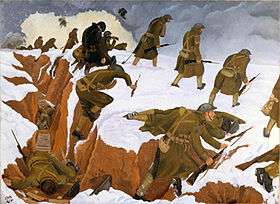
Following the formation of the Territorial Force, the Artists Rifles was one of 26 volunteer battalions in the London and Middlesex areas that combined to form the new London Regiment.[nb 2] It became the 28th (County of London) Battalion of The London Regiment on 1 April 1908.[9]
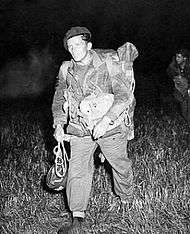
The Artists Rifles was a popular unit for volunteers. It had been increased to twelve companies in 1900 and was formed into three sub-battalions in 1914, and recruitment was eventually restricted by recommendation from existing members of the battalion. It particularly attracted recruits from public schools and universities; on this basis, following the outbreak of the First World War, a number of enlisted members of The Artists Rifles were selected to be officers in other units of the 7th Division.[1] This exercise was so successful that, early in 1915, selected Artists officers and NCOs were transferred to run a separate Officers Training Corps, in which poet Wilfred Owen trained before posting to the Manchester Regiment;[10] the remainder being retained as a fighting unit. Over fifteen thousand men passed through the battalion during the war, more than ten thousand of them becoming officers.[11] The battalion eventually saw battle in France in 1917 and 1918. Casualties suffered by both members of this battalion and amongst officers who had trained with The Artists Rifles before being posted to other regiments were 2,003 killed, 3,250 wounded, 533 missing and 286 prisoners of war.[1] Members of the Regiment won eight Victoria Crosses (though none did so while serving with the Regiment), fifty-six DSOs and over a thousand other awards for gallantry.[11]
In the early 1920s, the unit was reconstituted as an infantry regiment within the Territorial Army, as the 28th County of London Regiment. In 1937, this regiment became part of The Prince Consort's Own Rifle Brigade.[12]
The regiment was not deployed during the Second World War, functioning again as an Officers Training Corps throughout the war.[1]
It was disbanded in 1945, but reformed in The Rifle Brigade in January 1947 and transferred to The Army Air Corps in July as the 21st Special Air Service Regiment (Artists Rifles).[2] The number 21 SAS was chosen to perpetuate two disbanded wartime regiments 1 SAS and 2 SAS, with the 1 and the 2 being reversed into 21. The unit was active during the Malayan Emergency and in many subsequent conflicts. In 1952, members of The Artists Rifles who had been involved in special operations in Malaya formed 22 SAS Regiment, the regular special forces regiment – the only time a Territorial Army unit has been used to form a unit in the Regular Army.[13]
For much of the Cold War, 21 SAS's role was to provide stay-behind parties in the event of a Warsaw Pact invasion of western Europe (as part of the Corps Patrol Unit alongside 23 SAS and the Honourable Artillery Company (HAC)).[14]
21st century
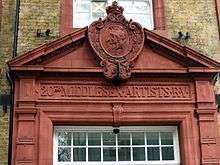
During Operation Herrick the reservists were involved in the training of the Afghan National Police.
A review was conducted of the unit's operational capability and role in 2009/10, it was found that the SAS Reserve lacked a clearly defined role, and also stated that the reservists lacked the capability, equipment, and skillset to serve alongside the regular special forces.[15]
As an outcome of this review, on 1 September 2014, 21 SAS was placed under the command of 1st Intelligence, Surveillance and Reconnaissance Brigade alongside 23 SAS and the HAC.[16][17]
They are tasked with providing Human Environment Reconnaissance and Analysis Patrols.[18]
Organisation
21 Special Air Service Regiment (Artists) (Reserve) currently consists of:
- 'HQ' Squadron (Regent's Park)
- 'A' Squadron (Regent's Park)
- 'C' Squadron (Basingstoke/Cambridge)
- 'E' Squadron (Newport/Exeter)
Battle honours
- Boer War: South Africa 1900–01.
- The Great War (3 battalions): Ypres 1917, Passchendaele, Somme 1918, St. Quentin, Bapaume 1918, Arras 1918, Ancre 1918, Albert 1918, Drocourt-Quéant, Hindenburg Line, Canal du Nord, Cambrai 1918, Pursuit to Mons, France and Flanders 1914–18.[1]
See Special Air Service for post-WW2 battle honours
War memorial
The unit's war memorial in the entrance portico of the Royal Academy at Burlington House commemorates the 2003 men who gave their lives in the Great War with a second plaque to those who died in World War II.
Victoria Cross
The following soldiers, who were members of the regiment at one time, were awarded the Victoria Cross in the Great War (none won the VC while serving with the Artists Rifles):
- 2nd Lt Rupert Price Hallowes, 4th Battalion, The Middlesex Regiment (Duke of Cambridge's Own)
- 2nd Lt Arthur James Terence Fleming-Sandes, 2nd Battalion, The East Surrey Regiment
- Capt The Rev Edward Noel Mellish, Royal Army Chaplains' Department
- Lt Geoffrey St George Shillington Cather, 9th Battalion, The Royal Irish Fusiliers
- Lt Eugene Paul Bennett, 2nd Battalion, The Worcestershire Regiment
- 2nd Lt George Edward Cates, 2nd Battalion, The Rifle Brigade (Prince Consort's Own)
- Lt Donald John Dean, 8th Battalion, The Queen's Own Royal West Kent Regiment
- Lt Col Bernard William Vann, 1/8th Bn, Sherwood Foresters
See also
- See also Category:Artists' Rifles officers and Category:Artists' Rifles soldiers
Notes
- ↑ Originally the regiment was designated as The Artists' Rifles until the apostrophe was officially dropped from the full title in 1937, as it was so often misused.[1]
- ↑ The Honourable Artillery Company and The Inns of Court Regiment were intended to become the 26th and 27th Battalions of the London Regiment. They were not satisfied with their high numbers so ignored them.[8]
References
- 1 2 3 4 5 6 Regiment, Artists Rifles Association
- 1 2 Gregory 2006, p. 297.
- ↑ Gregory 2006, p. xvi.
- ↑ Mars-Minerva (JPEG), Artists Rifles Association
- ↑ "Artists Rifles Association". Retrieved 30 December 2014.
- ↑ Gregory 2006, p. 80.
- ↑ "Artists Rifles Association". Retrieved 20 April 2012.
- ↑ Westlake 1986, p. 233.
- ↑ Gregory 2006, p. 96.
- ↑ The London Gazette: (Supplement) no. 29617. p. 5726. 6 June 1916. Retrieved 3 June 2009.
- 1 2 Higham 2006, p. xviii.
- ↑ Gregory 2006, p. 253.
- ↑ Shortt 1994, pp. 16–17.
- ↑ Ballinger 1992.
- ↑ Sean Rayment. HOME»NEWS»WORLD NEWS»ASIA»AFGHANISTAN. published by the Telegraph Media Group Limited 11 Apr 2010. Retrieved 2015-08-03.
- ↑ Janes International Defence Review, May 2014, page 4
- ↑ Army Briefing Note 120/14, NEWLY FORMED FORCE TROOPS COMMAND SPECIALIST BRIGADES, Quote . It commands all of the Army’s Intelligence, Surveillance and EW assets, and is made up of units specifically from the former 1 MI Bde and 1 Arty Bde, as well as 14 Sig Regt, 21 and 23 SAS(R).
- ↑ http://britisharmedforcesreview.files.wordpress.com/2013/11/force-troops-command-overview-and-brigades.pdf
Bibliography
- Ballinger, Adam (1992). The Quiet Soldier. Chapmans. ISBN 978-1-85592-606-6.
- Gregory, Barry (2006). A History of The Artists Rifles 1859–1947. Barnsley: Pen & Sword Books. ISBN 978-1-84415-503-3.
- Hacking, Juliet (2000). Princes of Victorian Bohemia. National Portrait Gallery.
- Higham, S Stagoll (2006) [1922, Howlett & Son]. Artists Rifles: Regimental Roll of Honour and War Record 1914–1919 (3rd ed.). London: Naval & Military Press. ISBN 978-1-84734-129-7.
- Shortt, James G. (1994). The Special Air Service. Men-at-Arms-Series, 116. London: Osprey. ISBN 9780850453966.
- Westlake, Ray (1986). The Territorial Battalions: A Pictorial History, 1859–1985. Tunbridge Wells: Spellmount.
- Winter, JM (1977). Britain’s ‘Lost Generation’ of the First World War. Population Studies. 31. p. 459.
External links
- www
.artistsriflesassociation .org - Artists Rifles on Facebook
- Artists Rifles on Twitter

- Artists Rifles on Pinterest
- "Art works presentation". Members of the Artists Rifles.
- "Army: Special forces". Supporting squadrons to UKSF. UK: MoD.
- "To enquire about joining 21 SAS(R) contact recruit enquiries".
